Thoughts on IDW Sonic #50, Imposter Syndrome, and pacifism discourse
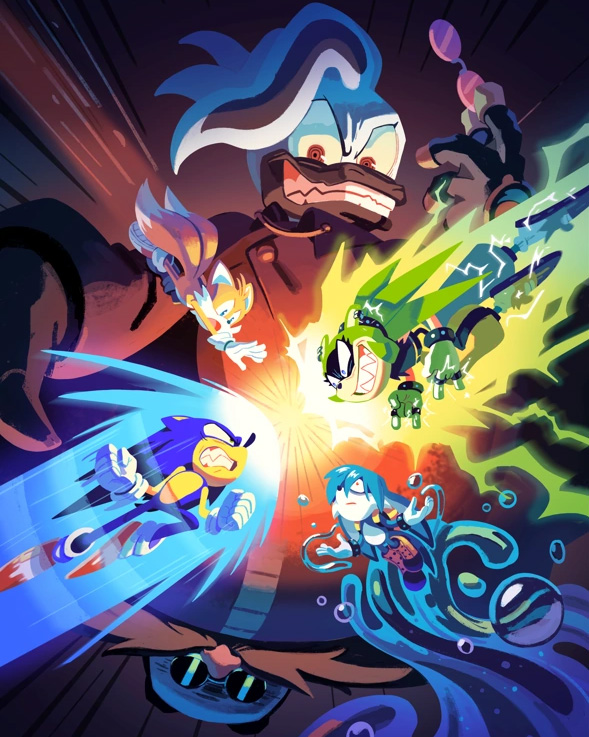
It’s finally here! IDW Sonic #50! I waited to talk about the Imposter Syndrome miniseries until after #50 dropped, and it turns out #50 has, uh… well, it’s made a big splash. I’m not sure I’ve seen this many people talking about (and/or arguing over) a single issue of Sonic in a long time.
As expected, in this post I’ll be talking about Surge, Kit, and Starline, but #50 has also given us a ton to chew on regarding Sonic and Eggman, Belle, and the overarching themes of the entire IDW series.
Let’s start out with the miniseries!
IMPOSTER SYNDROME
Surge rules

Can I just say that up front? That’s my main takeaway. Surge fucking rules
She was popular from the very second the first images of her dropped because Evan and Mauro came up with an extremely sick design, and the actual story does not disappoint. She borrows liberally from delinquent rival anime tropes (except, you know, she’s a girl, so it’s instantly even better), but that’s such a natural and fun addition to the Sonic cast that she instantly grabs you
And boy, if the writing and the strength of the design weren’t already enough, Thomas Rothlisberger’s art throughout the arc sure does. I’ve seen a lot of comparisons to Rise of the TMNT, which I can see. But Surge just makes so many good faces, constantly, and everything she does is cool. She’s angry teenage rebellion personified and she’s instantly become one of my favorite characters in the entire franchise, period. (Tangle and Whisper are also up there, so it’s safe to say the IDW comics have an extremely good track record when it comes to comic-original characters.)
Like seriously just look at her faces and tell me she isn’t the best
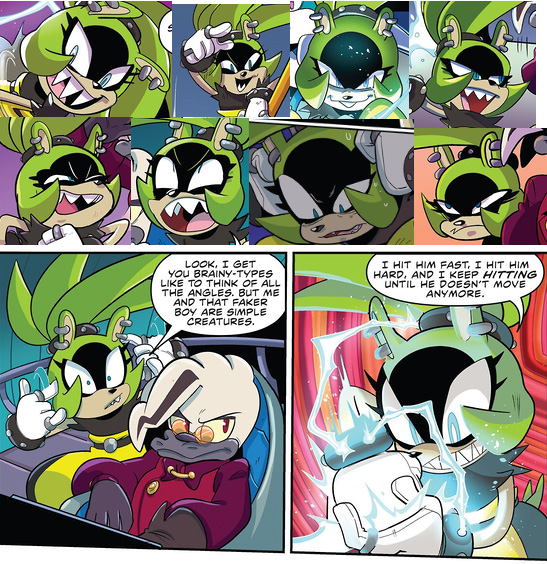
Kit, AKA “Aw Little Guy!!! Oh He’s A Little Bit Fucked Up Actually”
There were always hints that Kit had a sinister side to him - he is a villain, after all - but Surge stole the show at the start of the miniseries. This left Kit mostly as her meager sidekick struggling to please both her and Starline. In this way, he’s a dark reflection of Tails. Where Tails has become more independent over time, becoming more of an equal to Sonic, Kit exists entirely to support Surge. Starline made him this way, because this is how Starline perceives Sonic and Tails’ relationship. Starline doesn’t really understand people despite thinking he does, and this is what ultimately damns all of them
Naturally, this has left Kit kind of fucked up. Over the course of the arc, it becomes clear that he’s probably the scarier of the two. Surge might be stronger, but like Sonic, she wears her emotions and her intentions on her sleeve. But Kit? Kit suppresses his violent urges, until they build to a point where he can’t anymore
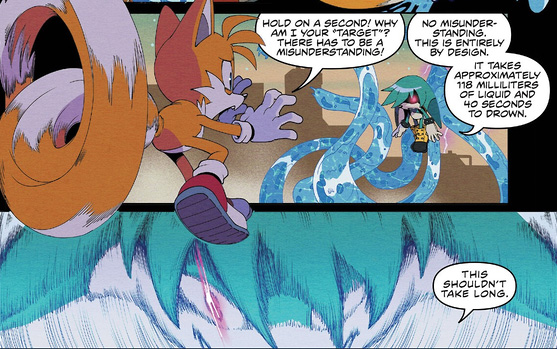
(these panels from #50 but still)
Holy shit, Starline???
I touched on Starline’s very meta plan earlier. I would have honestly been happy if Ian and co. had just added these cool new rivals for Sonic and Tails and let them duke it out, because they are, in fact, cool as hell. But the actual plot of the arc is more intriguing than that
Starline has always been a very meta character, with his main trait as a character basically being that he can zoom out and notice patterns in the franchise that other characters either can’t or won’t. He’s the guy who watches a movie and says how he would make smarter decisions than the characters the whole time. Early on, he did this with Eggman. He tried to “fix” Eggman’s methods so that he could finally succeed in beating Sonic and taking over the world, but this didn’t work out, and Eggman kicked him to the curb. He then decided that he would simply go solo and take over the world for Eggman. He finally reveals his true plan for doing so here: create his own “heroes” who can replace Sonic and Tails, the main heroes who always stand in the way of “progress” (Eggman taking over the world). In theory, this will allow Starline to control the hero/villain dynamic from both sides, ending the cycle of Eggman trying to “change the world” and Sonic stopping him
And of course, Starline calls this cycle he intends to break…
“The Sonic Cycle.”
I love you Ian
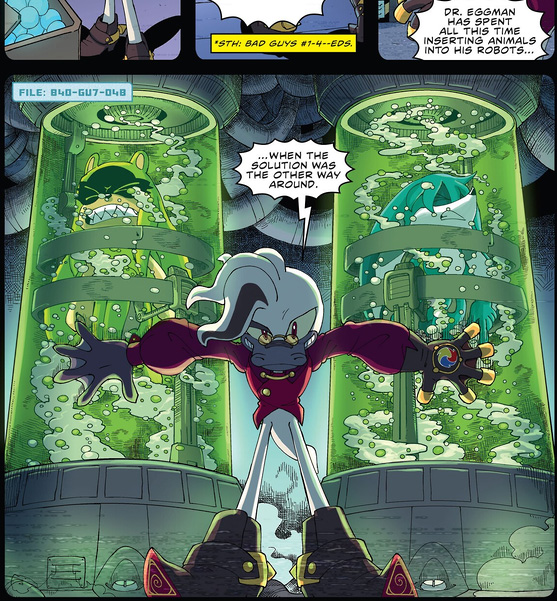
It quickly becomes apparently, though, that Starline’s plan here is, uh. Extremely fucked up! Wow! Early on it’s revealed that Starline has repeatedly been “rebooting” Surge and Kit. Any time the cracks start to show in their conditioning and they question their life stories, Starline’s orders, or their innate desires to defeat Sonic and Tails, Starline edits their memories. They do start to put two and two together, though, and eventually they learn the truth: they’re just two random kids Starline kidnapped and experimented on. They don’t remember their actual pasts, and Starline didn’t bother to keep track of who they originally were because he doesn’t care. They’ve been modified with cyborg endoskeletons and even have some of the Metal Virus in them, making them nigh-unkillable. Which Starline tested by… well, killing them repeatedly to make sure they always bounced back.
This is… so much darker than I would have ever expected? But in a fantastic way. It makes Starline SO absolutely despicable, and it gives Surge and Kit this pathos that makes you want to root for them, even as they set out to go rogue and burn the whole world down. Surge is very much set up as her own antihero in the buildup to her showdown with Sonic, which is a choice that I think leads to some fascinating character juxtaposition when it finally happens in issue #50.
Really, my only complaint about the miniseries was that the marketing made it seem like Sonic and Tails would be dealing with these two sooner, when in reality this is all the setup. The extremely hype wrestling promos for the climactic Wrestlemania that is Sonic #50. (My other complaint, I suppose, is that IDW is still having multiple artists trade off in a single story, which can be a bit jarring. But that’s a publisher-wide issue.)
But MAN. When we finally do get that big showdown? It does not disappoint.
SONIC #50
As with Imposter Syndrome, I went in expecting Sonic and Tails to fight Surge and Kit. And we absolutely got that with this extra-long issue penciled by Adam Bryce Thomas. Adam’s always been an A-lister on the IDW series, especially when it comes to bombastic shounen manga-inspired battles, but this issue might just be his best Sonic work yet
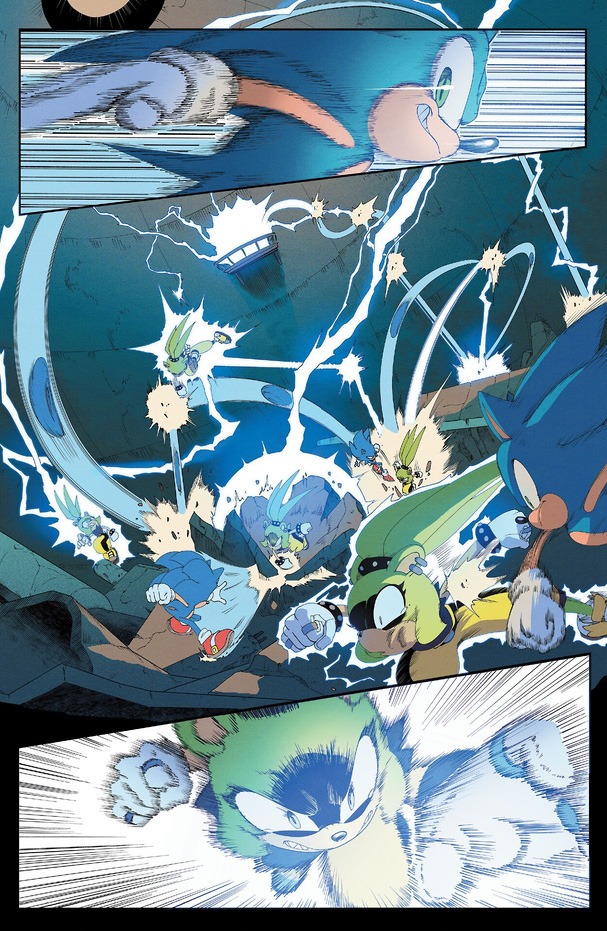
But like I said at the start, the issue is more than just some cool fights.
Sonic vs. Surge
Surge’s entire life, or at least what little of her life she can remember thanks to Starline, has been building up to this moment. Whoever she was before is gone, replaced with one purpose. She’s been impatiently awaiting the day she’s finally allowed to fight Sonic to the death. We’ve followed her through Starline’s inhumane training, the audience being equally antsy after months of buildup. At long last, she confronts him. She delivers an impassioned speech about what she stands for, how she curses the world that discarded her, how she’s going to tear Sonic and anyone else who stands in her way a new one…
And Sonic… doesn’t really give that much of a shit.
They do fight, of course. Boy, do they ever. But Sonic has never met this girl before and has no animosity towards her. He’s also done this too many times and would like to skip to the part where they’re friends, or at least frenemies. And this is just… tragic for Surge. For her, this is the most important day in her life. But for Sonic, it’s Tuesday. For Surge, this is a duel to the death. But Sonic, ever the unflappably positive shounen protagonist, is just having fun fighting someone who keeps him on his toes. He refuses to validate her on her terms.
(There are also a lot of interesting parallels with Tails’ simultaneous fight with Kit, where the kindhearted Tails is trying to be extremely nice and defuse the situation when he realizes that Kit is just some poor, fucked up kid. But instead of going on my own tangent I’ll link this very good TikTok analyzing Sonic’s social skills and the interesting ways his blunt, brash attitude can clash with the fact that he does genuinely care a lot.)
I even feel like Adam’s art is playing up the idea that Sonic’s attitude continues to make him the villain for Surge. His speech about his ideals places him above Surge, with a smug expression on his face and sunbeams shining down over him. Adam’s own (extremely sick) variant cover is framed very similarly, showing us the smug and above-it-all Sonic from Surge’s perspective.
Why does Surge think Sonic is so holier-than-thou? And why does she still care about fighting him if she just wants to defy Starline’s brainwashing? Well, she directly calls out his belief in the power of second chances, blaming Sonic for her very existence. Which ties back into what’s become one of the main recurring themes of the IDW series.
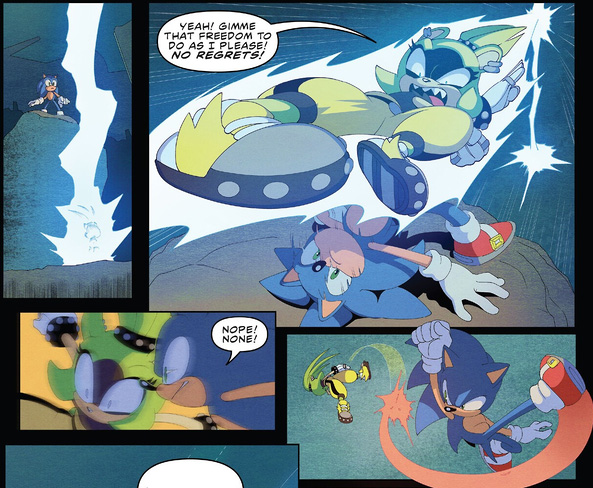
Sonic’s Characterization
As Ian’s explained, Sonic’s characterization in the IDW series has been informed by a number of factors. For one, more compassionate heroes are just landing better with audiences these days, including in shounen manga. Your Dekus, your Tanjiros, etc. But beyond that, Sega explicitly forbids Sonic and friends from proactively seeking out Eggman. Sonic is never looking for a fight. Eggman simply causes trouble, Sonic shows up to stop him, and he returns to being a free-spirited roamer.
Really, Sonic’s attitude in the current comics isn’t much different from how he acts in the games. Ian just decided to draw more attention to this behavior, and turn it into an explicit character trait that impacts the story.
I don’t really know what games people have been playing where Sonic DOESN’T act like this? Sure, there are a few games where a villain dies. There are always going to be counterexamples in a series as inconsistent as this. But look at how many characters Sonic has given second chances, and how lightly Sonic often takes threats to the world. Shadow was trying to blow up the damn planet and Sonic was still just having fun racing him on the ARK. Chaos destroyed a whole major metropolitan city and Sonic is like “hold on, Chaos is just hurt, we need to break this cycle of violence.” He’s ended up working with Eggman plenty of times to stop a greater threat. Even when this doesn’t happen, Eggman tends to just fly away at the end. Sonic never hunts him down. Again, Sega forbids him from doing this. It’s not in his character. The IDW comics just explore why.
At the same time, bad faith criticisms of Sonic’s willingness to give villains second chances tend to ignore the very important second part of this mantra, which this issue has Sonic spell out explicitly. Yes, he believes in giving people personal freedom. But the second they use that freedom to hurt people, Sonic is going to beat their asses again. He doesn’t have qualms about using violence in that way. He is, by no definition of the word, a pacifist. Sonic understands that Surge is traumatized, and tries to give her the chance to back down. She refuses, so he kicks her ass, because she’s a threat. Sonic sort of took mercy on the Zeti, in that he didn’t fucking execute them or whatever… but they also got banished back to the Lost Hex where they can’t hurt anyone. Tails disarmed Metal Sonic before they let him go. Sonic let Eggman go only because he had amnesia and Mr. Tinker was, by all accounts, a literal different person. The second he came back? Sonic gladly went right back to blowing his shit up. He is not out here handwringing about Eggman Empire property damage, he’s destroying his bases and smashing his mechs again.
Sonic also isn’t just any regular guy, and can’t always be judged as such. He’s a larger-than-life hero. He’s the embodiment of freedom, of endless adventure, of the power of friendship, of other idealized… well, ideals. This is the very core of his character. He’s the unshakably positive hero who never blinks in the face of danger, who the other, more realistically fallible characters can lean on. He’s a force of nature. He’s not perfect, and he doesn’t always handle things the right way, and other characters will bring up valid counterpoints to his way of life. Like other shounen heroes like Goku or Luffy, he might be a hero due to his actions, but he’s not concerned about being the world’s savior or its god. He doesn’t want to dictate how people live their lives. He leaves decisions about how to run society to other, smarter people, like the Restoration. He just wants to be free to go on adventures and to help his friends when they’re in need. His theme song spells out his whole deal, clear as day: It doesn’t matter who’s wrong and who’s right. He’s just living by his own feelings, and he won’t give in, won’t compromise. He only has a steadfast heart of gold.
Surge can’t stand this, though. The two just can’t see eye to eye. And so she zaps Sonic when he takes a time out in their fight to help her out of a chasm, getting the last laugh and seemingly falling to her doom. “That’s the real problem with giving people a choice,” Sonic solemnly says. “You can’t stop them from making the wrong ones.”
The Bigger Problem
Beyond any fandom bickering over how Sonic should or shouldn’t be characterized, though, this is part of a larger problem that I’ve seen way too frequently in recent years. Adults are engaging with genre fiction for children, and then getting upset when the child protagonists fail to model what they perceive as proper behavior for adults. Particularly, adults are seeing child protagonists learn to solve conflicts nonviolently, or even merely refusing to kill a villain, and interpreting this media as a political playbook for adults telling them that punching Nazis is bad.
That’s not to say that children’s media is never political, of course, or that you can never judge it through a political lens. (Back in the Archie days the direct political allegories were NOT subtle.) But just because some cartoon villains are obvious stand-ins for fascists doesn’t mean that every cartoon with a world-conquering villain is trying to tell you, an adult, how you should deal with fascists, or murderers, or whatever bad faith comparison critics on YouTube and Twitter want to make this time.
This will hopefully be insultingly obvious to most people reading this, but fiction isn’t always literally about the thing it’s depicting, or the closest real world equivalent. In genre fiction, and especially genre fiction for kids, reality is heightened. A fight for the fate of the city or the world or the universe isn’t necessarily about world-scale threats in real life like fascism, or even about real world violent conflicts in general. It’s often more about the emotions than what’s literally happening on screen. In a musical, when the emotions get too strong for words, they break out into song. In an action cartoon, when the emotions get too strong between conflicting characters, they fight. The fantastical violence is just the medium through which the story is conveyed. They trade blows and express their feelings.
Similarly, when the child hero in a series for children saves the day by hugging the right person, or when a villain is redeemed, or when Naruto espouses the power of friendship and uses Talk no Jutsu for the hundredth time, that isn’t telling you, a 30-year-old, that you can go out right now and save America by giving Mitch McConnell a hug. The morals of these stories aren’t necessarily supposed to apply to world-scale conflicts because children are not responsible for saving the world in real life. Instead, the lessons apply more to conflicts that children do deal with. Disputes with friends, or family members, or teachers. Things like that. It’s telling kids that hey, maybe you’ve been mean to people, maybe you’ve acted wrong, but you can learn from your mistakes and do better. That is what lessons about trying to resolve conflicts peacefully, talking about your feelings, empathizing with others, and giving people second chances are supposed to be about. They (usually) aren’t intended as political playbooks for adults telling you not to punch a Nazi, because the people telling these stories are probably hoping that adults aren’t modeling their political behavior after Cartoon Network and Shonen Jump.
But while I generally enjoy this compassionate take on the Sonic series, there is one part of the issue that felt weaker when it comes to the heroes showing compassion towards the villains.

Belle and Metal
If there’s one character from the games that I think Ian has always struggled with more than others, it’s probably Metal Sonic. Of course, not every writer is going to gel with every character, especially on a licensed series where you’re working with someone else’s cast. (Lord knows if I was to write a Sonic series I would play favorites lmao.) And Ian’s definitely put out some great Metal Sonic stories. But he’s also prone to boiling the character down to a simple killer robot for Sonic and co. to repeatedly defeat without any interiority.
Belle has also been a contentious character throughout this season. I’ll reiterate that I think Belle is great, and the big emotional beats with her have been strong. I would say the mixed response to Belle is primarily a matter of pacing, more than anything else. As Evan explained over on her blog, Belle’s backstory was originally just going to be a short one-off. When the 2021 Annual was replaced with the Classic Sonic special, Belle’s story got turned into the main overarching subplot connecting the stories of the third season. I do like a lot of the storytelling this allowed for. The buildup to the reveals in the Test Run arc, and her ensuing tearful breakdown; her questioning of her very nature as a Badnik; her heroic moments in Trial by Fire where she’s finally able to prove herself. It’s good stuff! Character arcs like this are why original characters are added to the comics in the first place. But I can also see how the slow and somewhat repetitive rollout of information and emotional beats is a bit much over a year and a half of comics, and it was a little odd to have her stick around as the only consistent main character for every single arc of the season as soon as we met her. But I still enjoyed her arc this season as a whole.
No, where I start to be more mixed on the direction of Belle as a character is this issue. Previously, Belle had made it her mission to try and save as many Badniks as she could. I understand her motivation, and I do think this has potential to be a fun premise. Badniks are EXTREMELY underutilized in the tie-in fiction, and anyone in this corner of the fandom who’s following artists like Hydro knows how fun it is to have Badnik characters around.
But the problem is, of course… if we start to recognize the Badniks that Sonic destroys casually as people, doesn’t that make it wrong for him to destroy them?
I guess it depends on the context, and how it’s executed in the future. Like, Motobud was fine because that’s not just A Motobug, but one that was specifically reprogrammed by Mr. Tinker to be friendly. But what’s Belle’s endgame here? Where is the line drawn between robots that need to be saved and simple obstacles for Sonic to pop in action sequences?
To me, we start to see the cracks in issue #50 with Belle’s attempts to save Metal Sonic. Metal is certainly no stranger to redemption arcs and characters trying to see the good in him - the OVA basically defined him as a character. But still. It’s admirable for Belle to see a robot who’s hurt and want to help, but the sympathy shown for Metal is laying it on a bit thick for me given Ian’s usual characterization of him as a missile with legs. Sonic already let him go once early in the series, but that was specifically because he thought Eggman was gonna remain Mr. Tinker forever at the time, and he and Tails also made sure not to restore his full fighting abilities. (”We’re compassionate, not stupid.”) But in this very different context, with a very different character, it’s just… eh, it didn’t sell me on this as a wise use of Belle’s compassion. If she wants to help the “abandoned” Eggman bots, Metal is very much not one of those. He just happened to have been hurt by Surge when they found him.
Not the end of the world, but it’s the weak part of what’s otherwise an amazing issue, and I worry that Belle showing complete and total sympathy towards every Eggman robot may get old fast. But, like I said, it will depend entirely on the execution. Maybe she’ll only single out the oddballs like herself and Motobud. It may not even be a huge element of the story moving forward, since I know Evan’s outright said Belle would be taking more of a backseat now that her initial arc is completed. (It also seems like Eggman wants to take advantage of the fact that she interfaced with Metal, so her kindness here may backfire…)
If anything, though, I do like the little awkward family reunion where Belle is telling Eggman that she’s done hoping he’ll go back to being Mr. Tinker and is gonna go live her own life and Metal is just kind of standing there because he won’t attack another Eggman creation.
Anyway! I can’t believe I haven’t mentioned the giant robot fight
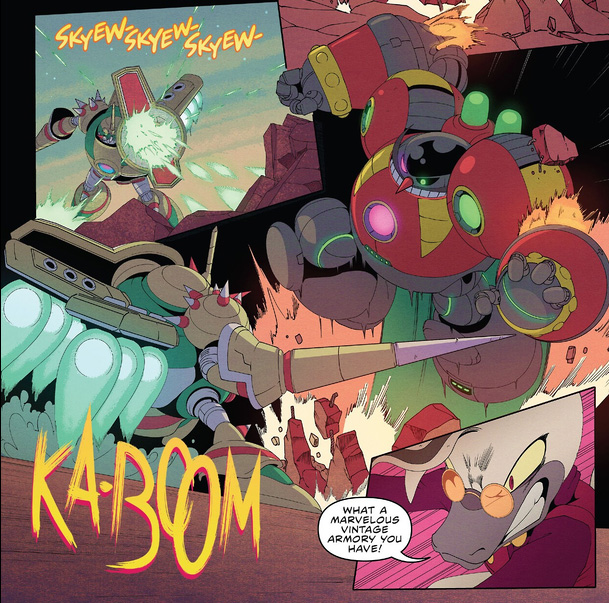
Starline’s Final Comeuppance
Sonic’s ideals, as explained in his fight with Surge, are also directly contrasted with Starline as he fights Eggman. Sonic stands for personal freedom, for better or worse, but Starline stands for total control, even more so than Eggman. He tries to manipulate people and the very story he exists in to steer everyone in the totalitarian direction he thinks is best. Anything outside of his narrative doesn’t matter. Even as Eggman is fighting him in a giant mech, he’s still under the impression that his actions are justified, that Eggman will be okay with being a pawn in his scheme so long as they get their happy ending ruling the world.
Instead, he loses a sick-ass mech fight, he’s humiliated worse than ever before, and then he dies!
I actually didn’t read it as a death at first because being crushed by rubble is such an easy “death” to write around, and it’s, you know, a comic book. Nobody stays dead in comic books. (We already know Surge survives this issue, regardless of how it looked.) But Ian did, indeed, intend for this to be Starline’s death. He also admits that that’s not entirely up to him since he’s not the only person making story decisions, so I won’t be surprised if he comes back in a year or two. Regardless, as much as I like the character, this is probably the most fitting death Starline possibly could have had. He thought he could outsmart Eggman, and the very nature of the series he’s in. Some readers, too, have accused Ian of writing Eggman as too much of a bumbling oaf in the IDW comics, especially with Starline always pointing out his mistakes. Even the marketing for this arc seems to have played into this, asking if Eggman would “bumble his way to a victory”
All this for the ultimate slam dunk in this issue where Ian definitively reminds us that, even if he can never beat Sonic… no one else can definitively beat Eggman, either.
Because Eggman fucking rules
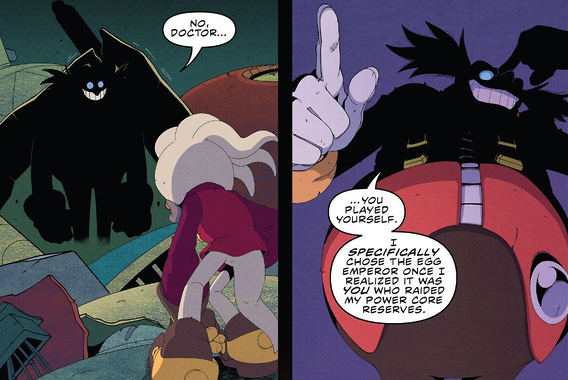
I said at the top that Starline is damned because he doesn’t understand people as well as he thinks he does. He creates Surge and Kit as dark and deeply broken reflections of Sonic and Tails because he so fundamentally misunderstands how their dynamic works. He thinks he understands Eggman, too, but he doesn’t. He may consider himself Eggman’s #1 fan, but he’s a toxic fanboy with faulty criticisms. He’s CinemaSins. He focuses on the details and the logic, he nitpicks, and he thinks he could do everything better if given the opportunity. He thinks he understands the nature of the series he’s in, but he fails to see the big pictures, the heart. He doesn’t understand why Sonic is really the hero beyond his strength and bravado. He doesn’t understand why Tails is a hero beyond his ability to support Sonic. And he doesn’t understand why, despite his many mistakes, Eggman will always endure as the true big bad of this world. And this leads to his downfall at the hands of his idol
I could say more about this issue and the ones that lead to it! I have obviously already said way too much. I’m gonna cut it off here!
Even with all the hype to live up to, this was an extremely satisfying issue of Sonic. One of the best in a long, long time. This one’s gonna stick with people. I have my quibbles, but it really has it all. Action, humor, drama, heart, stunning artwork, and a whole lot of character work to think about. Can’t really ask for more, can I?

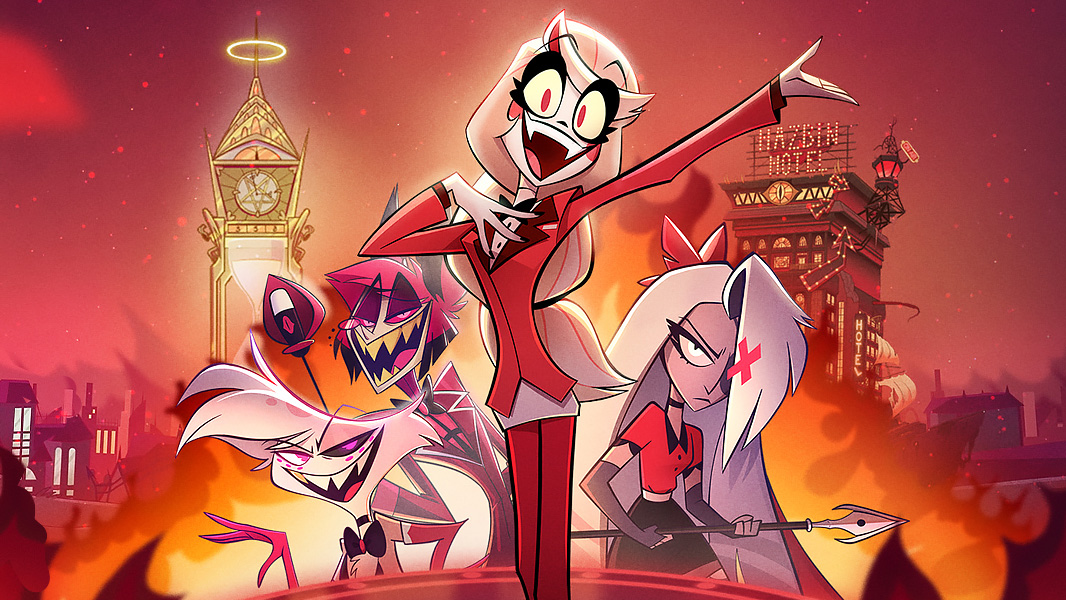
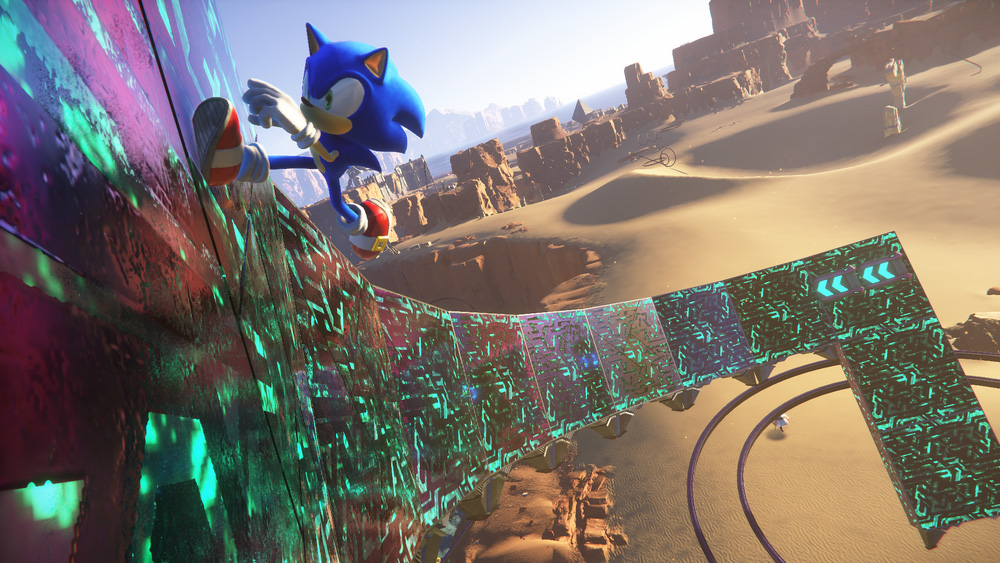
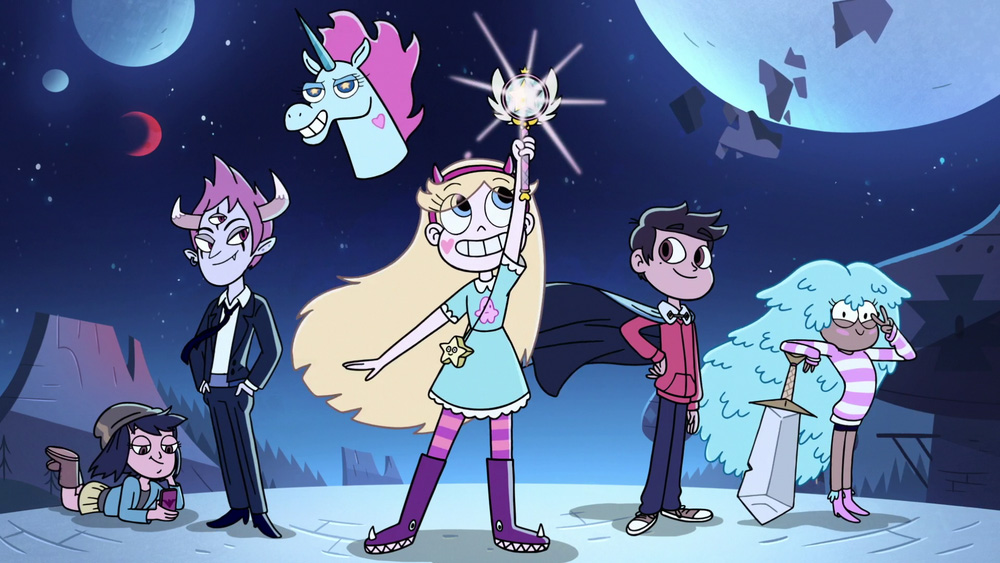
Comments